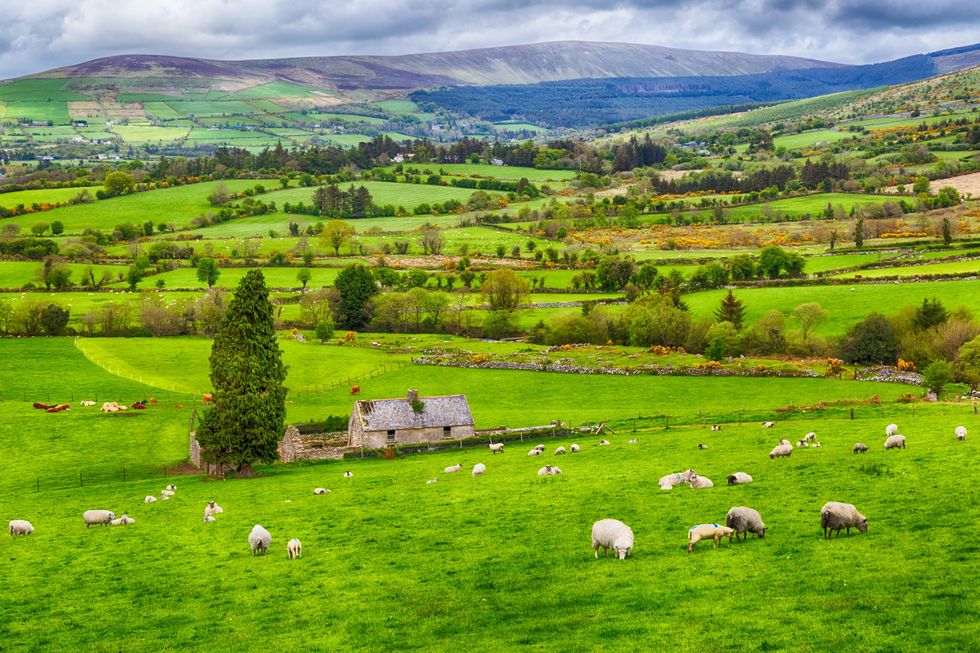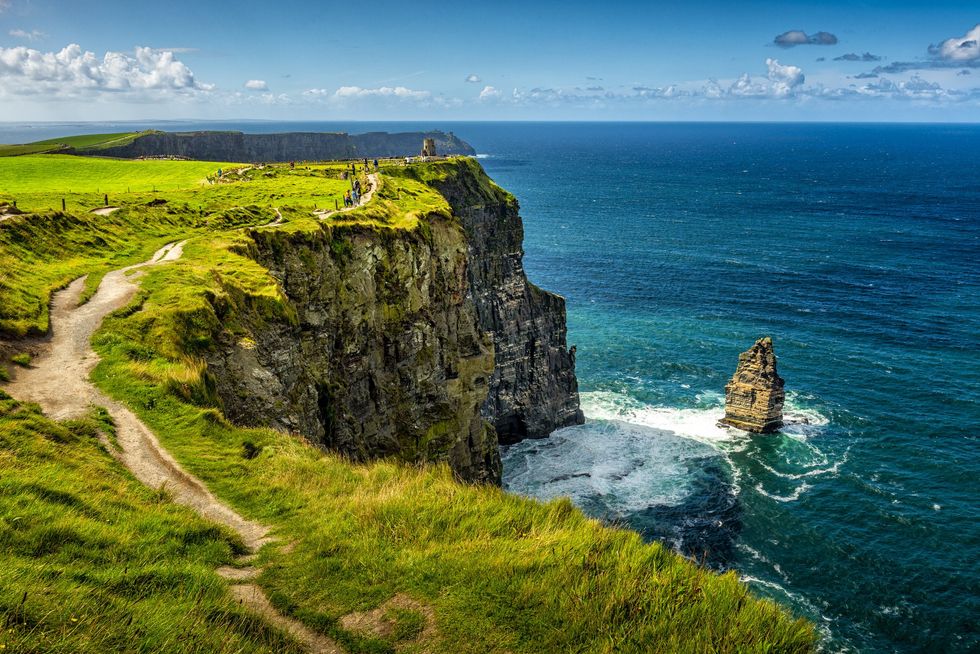
Strelciuc Dumitru/via Getty

The real truth of Ireland's historical genetics
Out along Europe’s western fringe, Ireland occupies a unique geographical and cultural space, where the continent ends and the vast ocean begins. Separated from Britain by as little as 12 miles (19 km), Ireland’s island history has been inextricably linked to that of its larger fellow island nation throughout the past, despite their deep current political differences. Curiously, due to the capricious winds of history, today it is the more geographically remote Republic of Ireland that shelters in the fold of the European Union, rather than Britain, with its robust record of involvement in the continent’s affairs. Buffered by the seas, Ireland has traditionally been overshadowed by Britain’s geopolitical machinations. In antiquity, when Britain was part of the Roman Empire, Ireland remained a barbarian land of myths, touched by Roman culture and trade but never by Roman politics or armies.
Because of its history, Ireland has become a sui generis creation on Europe’s edge, the farthest bank lapped by a broad stream of Northern European cultures that have flourished since the end of the last Ice Age, its people shaped by its isolation. The Emerald Isle is part of a larger story but comes bearing its own unique plot twists. It is also an island of unique genetic characteristics, most salient among them the highest frequency of red hair in the world, which is probably a legacy of migrations more than 4,000 years in the past.
Ireland remained neutral during World War II, and to this day, it stands committed to geopolitical neutrality. But even 2,000 years ago, its remoteness left it uniquely beyond Rome’s reach and geopolitical influence. Christianity did not spread to Ireland through pressure from the Roman Empire, nor did it arrive by winning over a powerful king, as occurred in most of Northern Europe. Rather, Irish Christianity developed organically through contact with Roman Britain (St. Patrick was in fact British), recruiting warlords of the island one by one over several centuries from 400 A.D. onward. Ironically, when Rome fell and Britain was conquered by pagan Saxons, Ireland instead remained a redoubt of Christianity, eventually sending missionaries to mainland Europe in the 500s and 600s who would found monasteries in the borderlands between Italy, France, and Switzerland. These Irish monks were also instrumental in converting the pagan Saxon kings of England to Christianity.

But Ireland’s remove from the currents of Northwest European history is not an eternal constant. The permanent human occupation of Ireland after the last Ice Age 12,000 years ago began as part of the broader resettlement of Europe’s deglaciated north that defined the early prehistory of Britain, Germany, and Scandinavia. The earliest Mesolithic hunter-gatherers relied on fishing and foraging along the maritime fringes after they arrived in Ireland, where the earliest archaeological sites cluster near the ocean. These earliest Irish foragers were genetically identical to their contemporaries in mainland Europe and Britain, and they all descended from small groups of humans who rode out the end of the Ice Age in favorable pockets of Southern Europe. When archaeologists began collaborating with geneticists ten years ago, submitting prehistoric remains to DNA-sequencing technology, they discovered that very little of modern Irish or Northern European heritage more generally derives from these first settlers, the “ Western Hunter-Gatherers.” One surprising aspect of these earliest inhabitants of Northern Europe was that they were strikingly physically different from today’s people in the region, with blue eyes but very dark skin.
Six thousand years ago, populous farming societies replaced the few thousand Irish Mesolithic foragers on the island. These people would usher in the Neolithic and eventually build vast passage tombs like Newgrange. A generation ago, there was a live debate as to whether these farmers were actually newcomers from the continent or foragers who adopted the practices of people to their south and east. Today, ancient DNA makes clear that on the whole, these were newcomers from the continent, part of a two-pronged push of agriculturalists from Anatolia that began nearly 10,000 years ago, spreading west across the Mediterranean to become the Iberian Cardial Culture and deep into the heart of Europe, via riverine valleys, to become the German Linear Pottery Culture. These two distinct streams of early agriculturalists eventually merged together in the northwest of the continent. But the Irish Neolithic people seem to have come more from the Iberian Cardial Culture, as the island’s farming societies show more genetic affinity with Iberian Neolithic people who drifted up along the Atlantic fringe than with farmers crossing over from northern Germany via Britain.
While the culture and history of Ireland over the last few thousand years have been marked by their distinctness from other societies, genetics and archaeology both indicate that during the Irish Neolithic, between 4000 and 2500 BC, the island was deeply integrated into the information and trade networks of continental Europe. Vast megalithic constructions, which reached their apogee in massive passage tombs, spread outward from Brittany 6,000 years ago, until they dotted the Atlantic coast of Europe from Denmark to Iberia, even reaching Malta in the Mediterranean. Genetically, we know the megalith builders were all the same people, Neolithic farmers most genetically similar to modern Sardinians. It is likely that they shared cultural affinities and adopted a new ideology during this period that involved the construction of monumental architecture.
Red hair as a trait in our species is not shocking, as many mammals and birds exhibit red pigmentation. The pigment that causes red hair, pheomelanin, is found in copious quantities in most humans. In most cases, we see it overwhelmed by the presence of eumelanin, the dark pigment that results in the majority of humans having black hair. Ultimately, the color of individual human hair is simply a function of the balance of these two pigments.
In Ireland, there are actually individuals buried in the great earth and stone tombs, and many have now been genetically analyzed by archaeologists and geneticists. Some of the results have been surprising. About 5,000 years ago, a high-status male was buried at Newgrange, and his genes suggest that his parents were probably siblings. Anthropologists note that this level of inbreeding is a hallmark of elites in societies that are extremely hierarchical, such as ancient Egypt or pre-contact Hawaii. The archaeologists also noticed that most of the elite males they found in other passage tombs across the island share the same Y chromosome, suggesting that the ruling class was defined by a particular paternal lineage, prefiguring the later Uí Néill (O’Neill) domination of Ireland. Finally, these elite individuals tended to look like most of the other people of Neolithic Europe, with dark eyes and hair and lighter skin, though a few had very dark skin indicative of some holdover ancestry from the earlier forager populations.
But affinities between the ancient and modern Irish only began to be established 4,500 years ago, with the arrival of a group from continental Europe to Britain and Ireland whom we term the “Bell Beakers” for their pottery style. As in Britain, the arrival of Bell Beaker people to Ireland was momentous, as over a few centuries the genetic profile of the island shifted from domination by people who resemble modern Sardinians to those broadly ancestral to the modern Irish. The arrival of these people brought a new paternal lineage: 90% of Irish and British Bell Beaker men seem to have carried Y-chromosomal haplogroup R1b-L21.
Today, two-thirds of Irish men bear this lineage, in contrast with 50% in Scotland and Wales and 20% in England. The divergence of Ireland from other regions of Northern Europe today appears to date from the Bronze Age 3,000 years ago, as subsequent waves of migrants and conquerors from the continent seem to have impacted Britain far more than Ireland (swamping out the British proportion of R1b-L21).
And it was with the arrival of the Bell Beaker people 4,500 years ago that the standard physical characteristics of modern Irish people also began to coalesce. It is then that samples from Beaker burial grounds first begin to indicate the presence of individuals with blue eyes, very light skin, and lighter hair. And notably among modern Western Europeans, it is populations from the Celtic fringe, Ireland and Scotland, that have the highest frequencies of red hair.

Pigmentation is one of any organism’s most obvious characteristics, and red hair is notable for its salience and rarity in humans. Celtic populations have very high fractions of red-haired individuals, around 10%, and this small minority often stands in for the whole group. The film "Brave," which centers around a young Scottish woman, predictably depicted the protagonist with a wild mane of red hair.
Red hair as a trait in our species is not shocking, as many mammals and birds exhibit red pigmentation. The pigment that causes red hair, pheomelanin, is found in copious quantities in most humans. In most cases, we see it overwhelmed by the presence of eumelanin, the dark pigment that results in the majority of humans having black hair. Ultimately, the color of individual human hair is simply a function of the balance of these two pigments. Most humans have both pheomelanin and eumelanin in abundance, so their hair is one dark shade or another. The coppery undertones evident in some individuals are simply due to the presence of pheomelanin that in others is more thoroughly dominated by the darker pigment. Those with very little of either variety of melanin may have blond hair. Finally, those individuals with very little eumelanin and copious pheomelanin will have red hair.
The combination of characteristics needed here, a great deal of the red pigment that is normally masked by the dark pigment alongside very little of the latter, illustrates why red hair is not common and often mistakenly perceived as “recessive.” The genetic variants associated with red hair have been localized to the melanocortin 1 receptor or MC1R. A critical regulatory gene in mammals relating to pigmentation, MC1R was the subject of much early work on pigmentation and coat colors in model organisms like mice. Twenty years ago, to explore pigmentation meant to examine MC1R, so its connection to red hair has long been established. In contrast, more recent pigmentation genetic variants discovered since the year 2000 have tended to account for variation in eye and skin color.
In fact, variation in this gene causing red hair probably predates modern humans. Some Neanderthals, who separated from our own lineage more than 600,000 years ago, likely had red hair. Obviously, we lack photographic evidence, but in 2007 geneticists managed to retrieve DNA from Neanderthal remains, and the region around MC1R exhibited all the hallmarks of numerous mutations that broke the function of the gene, resulting in loss of pigmentation. But this was more than just an educated guess. The team actually inserted an MC1R sequence with Neanderthal mutations into a bacterium to see if the gene would express the protein associated with a normally functioning gene, and it did not.
This prompted many to wonder if modern Europeans inherited red hair from Neanderthals. The genomic evidence says no, as modern Europeans have a new cluster of mutations that cause the red hair phenotype, distinct from those seen in their Neanderthal ancestors. In fact, though in mainland Europe red hair is most common in the far northwest, in Ireland and Scotland (the correlation between the R1b-L21 Y chromosome and the frequency of red hair is actually quite high), it is also common on the far northeastern edge of Europe, among tribal Uralic people like the Udmurts.
As the same genes are implicated in pigmentation variation right across species (the gene most responsible for lighter skin in Europeans, SLC24A5, was first discovered in small fish), it is no surprise that MC1R can mutate to produce red hair in separate human lineages in different ways. Not only does MC1R have a major role in pigmentation (as the name would indicate, melanocortin being implicated in the production of melanin), but it is also involved in our inflammatory response and development of cartilage, as well as correlated with different cancer risks.
Perhaps the most curious aspect of red hair in humans is its strong association with the need for greater anesthesia levels due to higher pain sensitivity. Unsurprisingly, both humans and mice with MC1R mutations need higher levels of painkillers to experience the same effect as those with more common genotypes.

Today, thanks to ancient DNA and archaeology, we know that the people who brought red hair to Ireland and the related Celtic nations of Wales and Scotland were likely the Bell Beakers, carriers of the Y-chromosomal haplogroup R1b-L21. This association is even present in southwestern Norway, where the fraction of red hair and R1b-L21 is higher than in the rest of Scandinavia (this was an area where during the Dark Ages, Vikings brought Irish slaves back with them). Looking at patterns in the ancient DNA, it is now likely that the genetic and cultural differences between Ireland and England only began to accumulate 3,000 years ago, as Ireland remained insulated from migrations and movements that repeatedly overwhelmed its eastern neighbor. The unique character of the modern Irish, then, goes back to the Beaker people 4,500 years ago, as the dark-skinned Mesolithic foragers and the dark-haired builders of Newgrange left little genetic legacy in the modern people.
But mysteries remain to be unpacked. We know that the modern Irish have among the highest frequencies of red hair, but we do not understand the evolutionary adaptation that drove this trait to become somewhat common among the Bell Beakers’ descendants. It is perhaps too coincidental that Neanderthals, Celts, and the Udmurt all occupy very high latitudes in Eurasia, suggesting some possible compensation for limited sunlight. But then again, Scandinavia is dark for much of the year, and red hair there is rather uncommon. The reality that MC1R regulates many characteristics, from pain to cancer risk, points to the possibility that there is an unknown benefit to red hair in certain populations to which we remain oblivious.
Perhaps, then, Ireland’s genetic and cultural isolation for the last 3,000 years can be seen in this light, as a separate and distinct laboratory of evolution from other regions of Northern Europe. This is not to say that Ireland was entirely isolated, as Britons brought Roman Christianity and Vikings founded settlements like Dublin and Cork around the fringe of the island more than 1,000 years ago. But its unique geographic position, facing onto the unbounded Atlantic ocean to its west and insulated even from Britain to the east, has allowed Ireland to slowly careen off on its own idiosyncratic path, buffered from the turbid tides of much of European history since the time of the Greeks and Romans.
Editor’s note: This piece was originally published on Razib Khan’s substack Unsupervised Learning. He is a geneticist and polymath who writes about history, politics, evolution, and books. You can follow him on X @razibkhan and consider supporting his work at razibkhan.com.
- YouTube youtu.be
Razib Khan